AN INTERVIEW WITH CRAIG SCHULZ AND STEVE MARTINO FROM “THE PEANUTS MOVIE”
To help celebrate the release of The Peanuts Movie, it was declared Charles M. Schulz Day here in Minneapolis on October 20, 2015. Steve Martino, the director of the film along with writer Craig Schulz and various cast members were on hand to celebrate. I had a chance to interview Martino and Schulz along with fellow film bloggers Ruth Maramis from www.flixchatter.com and Emmylou Barden from www.donnahup.com
Paul McGuire Grimes: What inspired you to bring it back, rejuvenate it, and bring it to a new audience?
Craig Schulz: A couple of things. It was eight years ago when I had the idea for the movie. There was a challenge to start it, how was I going to get this passed the family, and New York, find a studio, and everything else. I was determined, so it was an uphill battle. We went through a lot of steps to get there, and at one point I sat down with Bryan, my son, and Neil [Uliano] who are the co-writers of the project and producers, and we spent a month locked up in a house together crafting what would be the treatment for this movie and then we met with Ralph from Fox and Ralph loved it. He said “We’d love to buy it” and it was a matter of finding the team to build it. Bryan had met with all the studios and we decided that we liked what Blue Sky had done and knew what Steve [Martino] had done in the past. We called them and said “Let’s make this movie”
PMG: How long did it take to get the animation correct in taking the 2D that everyone knows and loves to really making sure the 3D animation was correct and that it felt within what your dad created?
CS: Steve can answer that best.
Steve Martino: I think, for us, that first year of development was critical. I went into it with a couple of objectives. 1) I thought the paintbrush we use today is computer animation, and I knew, as a fan, anybody would read that in an article or on a blog would be like “Really? Computer animation?” that they would be lined up ready to give us a hard time. The team that I work with at Blue Sky locked arms and said, “Look, we’re going to approach this film in a way we never have before. We studied the way Bill Melendez animated the characters in 2D and we emulated a lot of that thinking in the way we’ve animated the characters in our world. I thought there would be a nice advantage in using computer animation in making the environment feel a little more real. Still in the wonderful style of Charles Schulz, everything needed to feel handmade and drawn. My mantra to the team was that I wanted to feel the pen line in everything we put on the screen. With that, it was a year. We knew we had a year or year and a half before we had to put out that first image. Craig was along for that entire journey. There were times where we put some imagery together that didn’t feel quite right and we’ve had some Charlie Brown moments where we had to pick ourselves back up and go “No, we can do this.”
PMG: Did you literally say “good grief” at the same time?”
SM: I’ve got to tell you, there were days when we had great intentions and something just didn’t look right, and I’d go home and Charlie Brown really became a mantra for me on the film. When it was a really bad day, I had a Charlie Brown sweatshirt and I would wear it the next day and say “Today’s the day when we’ll win the game or fly the kite today.”
CS: There were days where it was a struggle to get some stuff right. At Blue Sky, they have a fur guy, a hair guy, and a feather guy. We’re just trying to get Charlie Brown’s squiggle in the front right. Steve would come to me and say, “look at these different hair things” and we kept battling with it. Finally I said, “Can’t we just go back to the line art how dad drew it?” We’d talk about Linus and his hair going up. How do we fill in the bald spots and then deal with the eyeballs? Trying to create the emotion of the whites of the eyes. I told Steve about a special I’d seen on TV called “The Umbrellas” where all they had was two dots for eyes and we had a big discussion on eyes. He put the challenge out to the group to try to deal with what we had to make it work. It was a big challenge, but it paid off in dividends at the end because everyone stepped up to make it work without going to something that would make it look really weird. It didn’t take much to make them weird.
SM: For us, it ended up being probably the most technically challenging film that we’ve ever worked on to make something look so simple. Because that’s all that really matters in the end is that when Charlie Brown speaks, you want to feel that he’s come to life. I mean that really is what animation is about. We create the illusion of life with pixels, with drawings. We have a fair amount of 2D hand drawn animation
PMG: All of the flashbacks that you do were just so creative, and the way you then use the 2D original drawings were super creative and a good use of that.
SM: I’m so proud of the team. There’s one artist in particular who’s a 2D traditional artist and I think that he’s done some of the most wonderful interpretations of Charles Schulz’s ink work where we really tried that thin/thick pen line and make it come to life on the screen whenever Charlie Brown is imagining you know what’s going on in his mind. To me, we’re looking at the daily strip, it’s black and white, pen and ink, it’s 2D.
CS: The other missing thing for me was this was the first animation that’s been done where we don’t have the black outline of the characters. I hadn’t really thought about that until we started to process. I think someone mentioned that to me. “What are the edges of the characters going to look like? They don’t have the black line that your dad did with the big and small. Is it going to look like a toy, a stuff animal?” And yet it came out beautiful and I guess that’s the lighting effect guys that created the magic of that stuff, just getting that head to glow just right and create the sphere just right so it didn’t look like a planet.
Emmylou Barden: My brother used to make fun of me and say I was the Charlie Brown because I was really bad at things. I was wondering now that you’re adults and look back at your life, if you have advice for the Charlie Browns? What would you say to them?
SM: That’s the heart of the movie, to be perfectly honest. The way Craig and Bryan and Neil looked at the body of fifty years of who Charlie Brown was, and I think what I’m happiest about is thematically in the film what we hold up are the qualities that Charlie Brown does have. We focus on the failures and love to laugh at those because we see ourselves in that a little bit, but what is wonderful about him as a character is that he is kind, honest, and with every failure comes the other side of Charlie Brown is great perseverance. He always picks himself up and tries again. That is the heart and soul of the movie that we see him go on a quest to try to be a winner and try to win that gold medal. In the end, he may not achieve that but the qualities that he does have, and this is a great lesson for me or anybody in our own lives, that those things are more valuable. How you treat your friends. How you live your life can make…those are the qualities of a winner.
Ruth Maramis: What’s the international appeal of the story? I know the story is universal. There’s an underdog in any culture that would translate. Is that something that you are mindful of for people that might not be familiar with the characters? When you’re making movies these days you kind of have to think international.
SM: Our audience is a global audience. We no longer make movies for the US market. The world is our audience.
RM: The story is so universal and relatable. Can you talk a little bit about that, as this is the fifth Peanuts film?
CS: You really can’t go wrong by going back to the source. When Bryan and I started the project, the idea was to stick within the comic strips and stick within the context of what my dad had done for fifty years. Again, that’s that universal appeal and no matter what country you’re from, you’re dealing with the same problems. Do people like me? How do I meet that beautiful girl over there when I lose a lot more than I win? The message is universal. His work is really a study in humanism and he expresses that through the comic strip, so it should translate well. We’re going to China and Japan and all over the globe, and we hope it does. We wrote the movie staying within the context of what he did before.
RM: That’s what I love. The balance of teachable moments. Things that kids and adults can learn, but also have that adventure and fantastical elements with the dream sequences. They’re just so entertaining and you’re so moved by it. There’s the emotional core to the story. I want to applaud that.
SM: I think that’s the key to a good movie is that you want to have a range of emotional feelings when you go into a theater. Peanuts is perfect for this because there’s heart and you can get emotionally invested in the characters, but you want to have a lot of laughs as well, and Snoopy is just the best character ever.
PMG: Those scenes are so great. He just comes alive essentially without saying anything. It’s so hilarious.
SM: That’s animation at its purest form. That is a language that ascends language. It plays in any culture because its pure pantomime. It’s what we love to create as animators because it’s all on us to bring the fun to life. You mentioned with Snoopy and his adventures, we also felt that a movie going audience today wants some moments where they are on the edge of their seat and get some scope and dynamic action. We felt with the story that Craig, Bryan, and Neil put together that we’d have an opportunity to fly with Snoopy as the flying ace against the Red Baron and that we could make something bigger, more dynamic than had ever had been done with the flying ace in the past.
RM: The aerial sequences are great as it looks almost realistic and you look at Snoopy and remember, “oh, that’s right, it’s a cartoon.” It’s so easy to forget because it’s so beautiful. They’re in the clouds…
SM: Snoopy has a big imagination, and it had to be big.
PMG: I want to ask about the casting of the kids. Was it more important to get the essence of each kid or that they could sound like the former actors that were voicing the characters?
SM: It started with the first conversations Craig and I had. For me, Charlie Brown is the voice that was in the Christmas special. I was six years old, and that imprinted on me. That’s who Charlie Brown is. That’s who Linus is. All of the characters. As I worked with our casting director, Christian Kaplan, the objective/the mandate was that I wanted to find a vocal quality that matches that because I’m asking an audience and fans to come in on this ride with us to watch this film. I don’t want them bumped out on the first frame of the film by hearing a voice that seems wrong.
PMG: Lucy in particular was so accurate. I knew that it wasn’t [the old voice] but it was a close impersonation.
SM: Craig gave some great advice as we were doing our casting, and that was besides having the kids read the lines, just have conversation with them. Let them talk in their natural voice. I know from all of the work I’ve done with other actors that we’re in our best place when people are just performing naturally and we’re not putting on a voice. With kids, I didn’t want anybody putting on a voice. I just wanted their natural qualities. What we learned from that process, you know, Charlie Brown has that slow and steady demeanor and you need to see that in the actor, in the child that you’re casting. I tell you, the one story that didn’t follow that was Lucy, Hadley Miller. I met her the first day and heard her audition tapes, and she sounded great. When I met her, she was the most polite, sweet nice girl and in the back of my mind what’s ticking around is, “Oh my gosh, can she be Lucy?” She’s got to be bossy. She’s got to get in Charlie Brown’s face.” Sure enough, we go into the recording session and the second line we did called upon her to bring it. I set up the scene. I always act against the kids and she just turned on Lucy and I blew back in my seat. When she was done, I was like “Oh my God, it was amazing.” And she goes “oh, thank you” in the sweetest most delicate voice. She was one by her natural demeanor that you wouldn’t see a Lucy there. With the rest of the kids, you kind of see the character in them.
RM: She’s a young Meryl Streep there.
EB: If you had to convince someone who was in-convincible or seemed that they didn’t want to see the movie, as it wasn’t like the classic version, what would you say to them?
CS: I would say that it’s not like the classic version; it’s an extension of the classic version. When you see the characters, you see them in a light that’s new and fresh, on the other hand, it’s recognizable. To me, it’s actually better. I think they are more identifiable. They’re more real. You feel more connected to them. They don’t feel as distant as they did in 2D animation. To me, I think it’s a wonderful medium. I would never have guessed it would have been this good.
SM: For me, I would say to them if the things that you loved about reading the comic strip or the earlier specials, the heart, the emotion, and the laughs that you have with these characters, we have retained every bit of that. That’s the core of what Peanuts is. The core is at the heart of the story. Come out to the film and feel it.
RM: And the music. David Benoit. I actually know David Benoit mostly because of the Peanuts music that he wrote. I think he did a memorial album for Charles Schulz.
CS: He’s done a lot of stuff for us. That’s why we brought him on. I called Steven and said, “Let’s bring David on.”
SM: One of the greatest days on the scoring stage was our jazz combo day. We got David Benoit on piano, we had stand up bass, and we got the vibraphones. It was fantastic, and Christoph Beck who’s our composer did a wonderful job. It’s the same challenge as us animating these characters. There’s a lot of history to the music of the Peanuts film, and he embraced the philosophy Craig and I had on the movie, which was to tell a feature film story with these characters and to create emotion. He used everything within that palette. There are moments that we are flying with Snoopy that will have full orchestra, and there other moments where the jazz combo just lays it out there. Meghan Trainor wrote two original songs for the movie.
EB: I really liked them.
SM: She really seemed to get Charlie Brown and this story in particular.
RM: Did Christoph Beck and David Benoit actually work together?
SM: Christoph Beck wrote the score for the movie, and yes they worked together on the performance. David Benoit added all of the piano work to the film.
RM: I am ear candy!
SM: That’s wonderful.
PMG: Thank you so much.
EB: It was so nice to meet you.
RM: Thank you for coming here.
SM: It’s the home of it all!
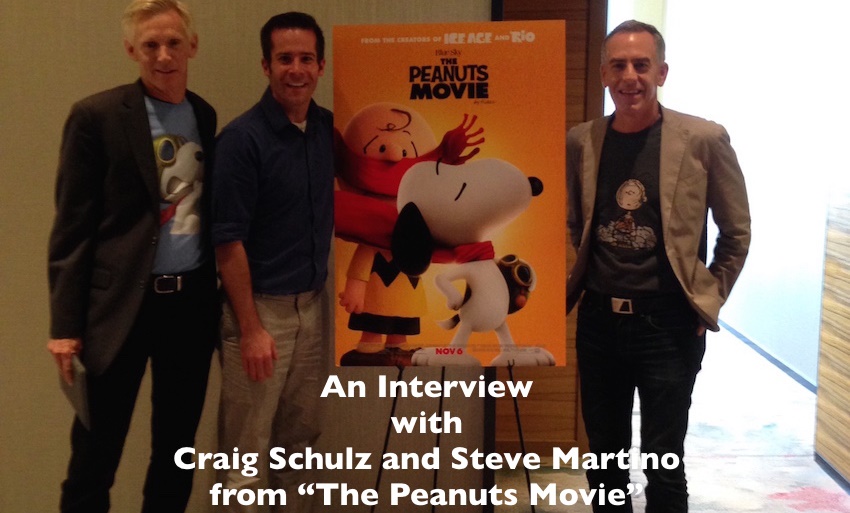
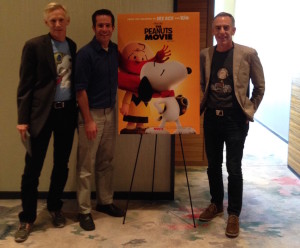
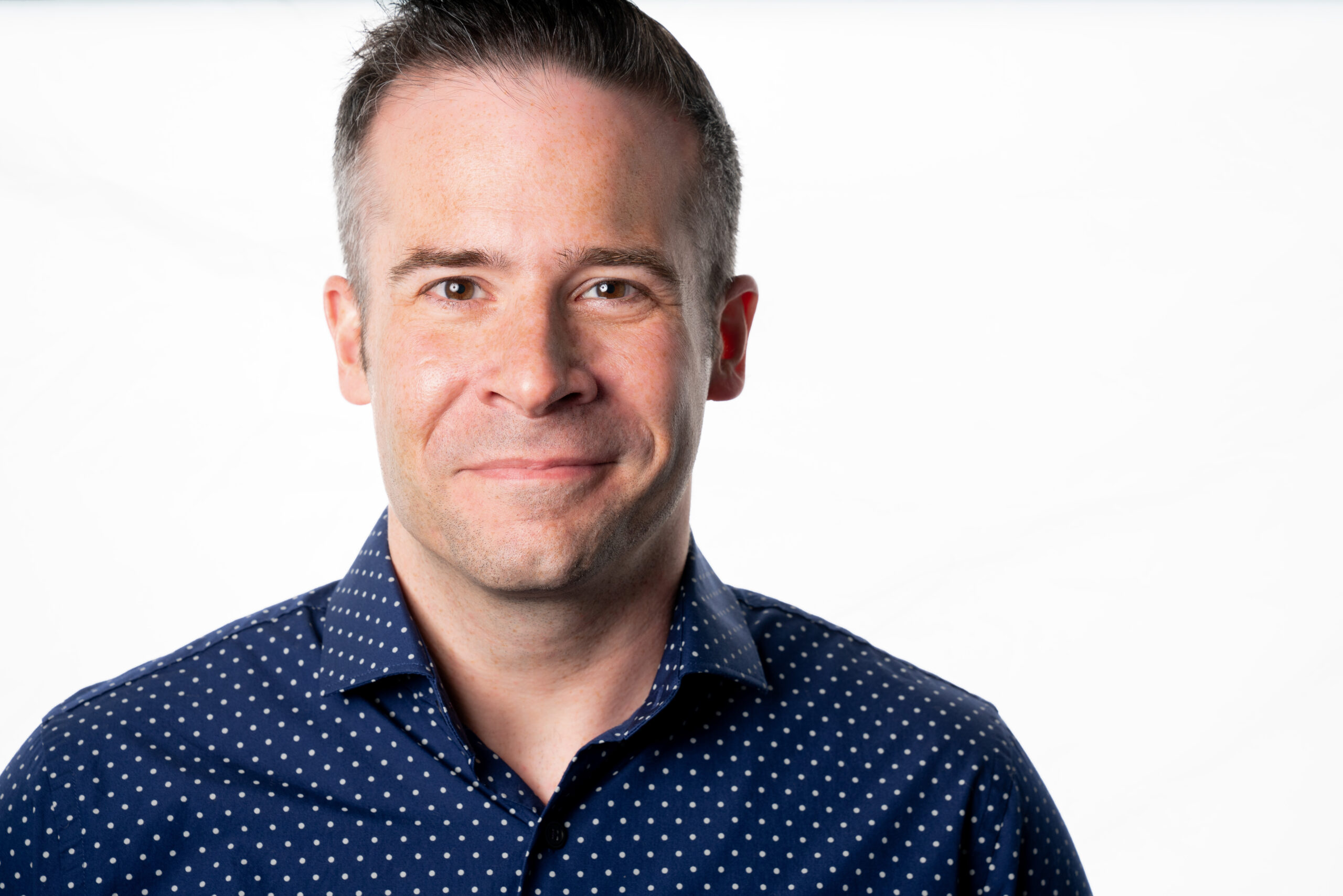
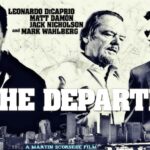
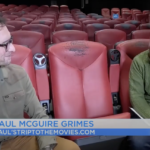



One response to “AN INTERVIEW WITH CRAIG SCHULZ AND STEVE MARTINO FROM “THE PEANUTS MOVIE””
[…] director Steve Martino that same week, along with fellow bloggers Paul McGuire Grimes from Paul Trip’s To The Movies and Emmylou Barden from Donnahup.com. Thanks Paul for helping transcribe the […]